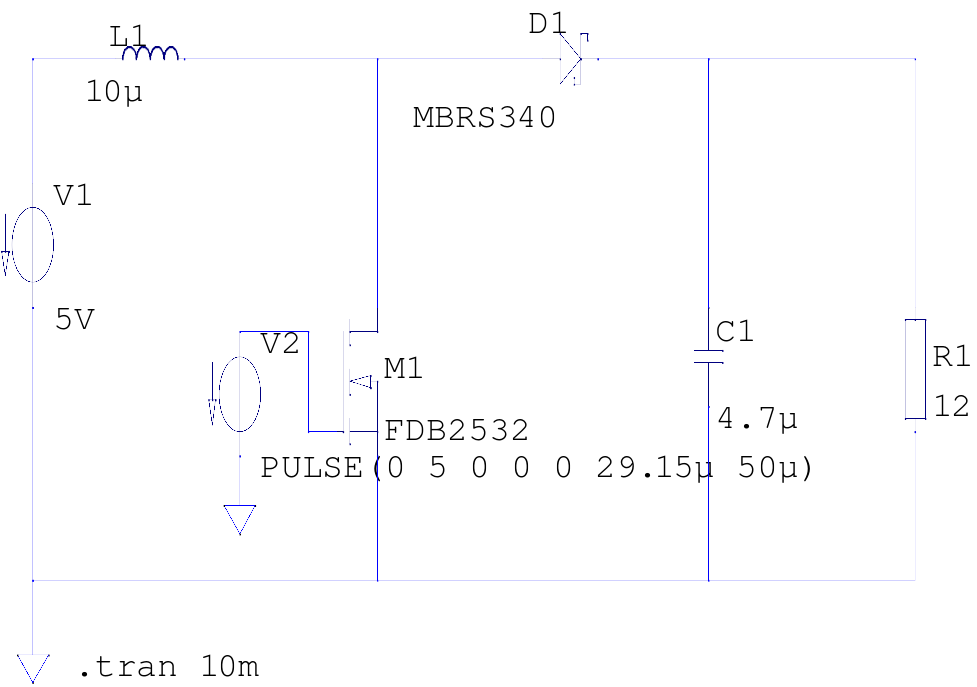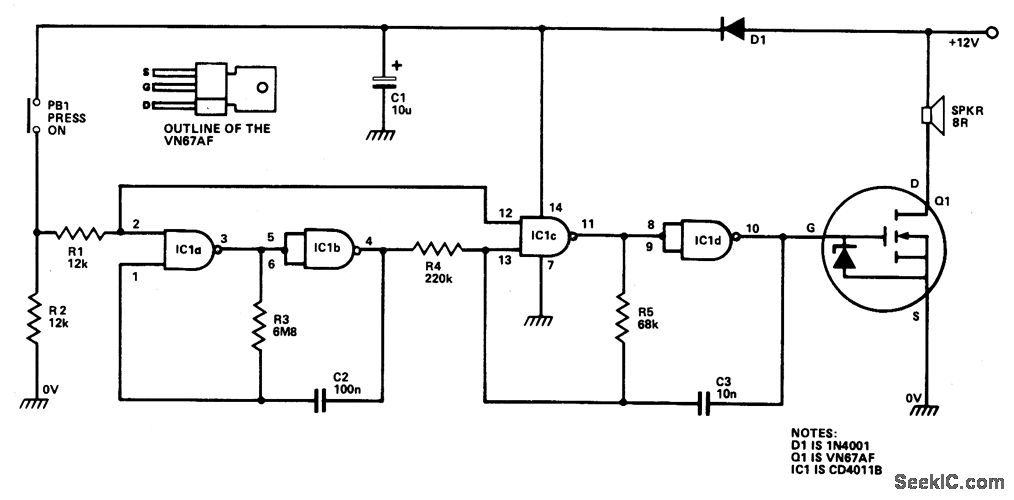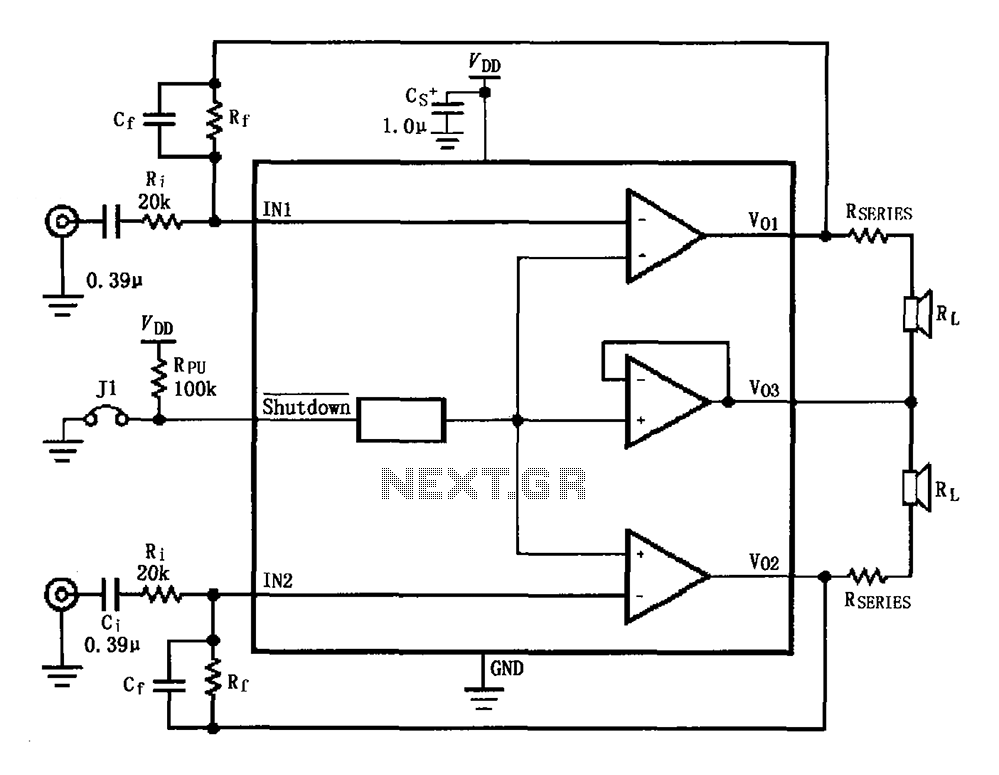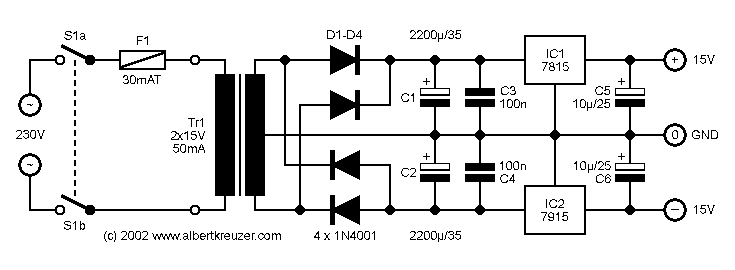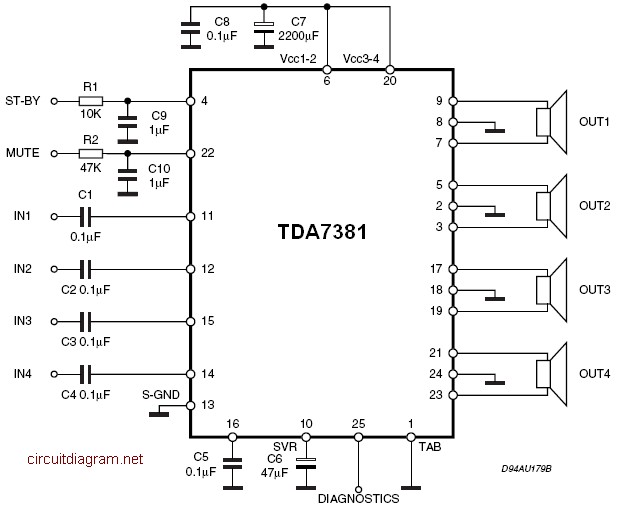
Audio Power Meter
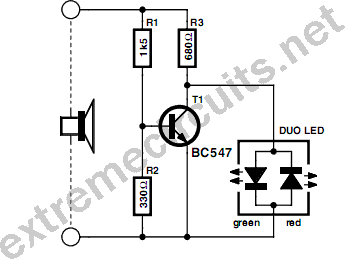
This simple circuit indicates the amount of power delivered to a loudspeaker. The dual-color LED displays green at an applied power level of approximately 1 watt. At 1.5 watts, it glows orange, and above 3 watts, it shines bright red. The circuit is connected in parallel with the loudspeaker connections and is powered by the audio signal. The additional load represented by 470 Ohm (R1//R3) will not pose a problem for any amplifier. During the positive half-cycle of the output signal, the green LED in the dual-color LED will illuminate, provided the voltage is sufficiently high. At higher output voltages, T1 (depending on the voltage divider R2/R1) will begin to conduct, causing the green LED to turn off. During the negative half-cycle, the red LED is activated through R3 and will turn on when the voltage reaches a sufficient level. In the transition region, where T1 conducts increasingly and dims the green LED, the combination of red and green produces the orange color of the dual-LED. By selecting appropriate resistor values, the power levels can be adjusted accordingly. The values chosen here are suitable for typical living room use. Users may be surprised at how loud the amplifier must be turned up before the LEDs activate. The resistors can be 0.25 W types, provided the amplifier does not deliver more than 40 W continuously. Beyond this power level, the transistor may not function optimally, so caution is advised. Since T1 operates in saturation, the gain (Hfe) is not critical, allowing for the use of any similar type. The power levels specified are applicable for 4-ohm speakers; for 8-ohm speakers, all resistor values must be halved.
This circuit serves as a power indicator for audio amplifiers driving loudspeakers, utilizing a dual-color LED to visually represent the output power levels. The circuit is designed to operate in parallel with the loudspeaker, effectively monitoring the audio signal while introducing minimal additional load. The configuration incorporates a 470 Ohm resistor in parallel (R1//R3), ensuring that the load does not adversely affect the amplifier's performance.
The operation of the circuit hinges on the characteristics of the dual-color LED, which changes color based on the power levels detected. The green LED indicates a low power output (approximately 1 watt), transitioning to orange at 1.5 watts, and finally to red at power levels exceeding 3 watts. This color change is facilitated by the transistor T1, which is controlled by the voltage divider formed by resistors R2 and R1. As the output voltage increases during the positive half-cycle of the audio signal, T1 begins to conduct, causing the green LED to turn off and allowing the red LED to illuminate during the negative half-cycle.
The design allows for flexibility in adjusting the power thresholds by modifying the resistor values, accommodating different listening environments and amplifier specifications. The use of 0.25 W resistors is adequate for amplifiers with a maximum continuous output of 40 W. However, exceeding this power rating may lead to overheating or failure of the transistor. It is also important to note that the circuit's specifications are tailored for 4-ohm loudspeakers; adjustments must be made for use with 8-ohm speakers, specifically halving the resistor values to maintain accurate power indication.
In summary, this circuit provides an effective means of monitoring loudspeaker power levels in audio applications, combining simplicity with functionality while ensuring compatibility with a variety of amplifier configurations.This simple circuit indicates the amount of power that goes to a loudspeaker. The dual-color LED shows green at an applied power level of about 1 watt. At 1. 5 watts it glows orange and above 3 watts it is bright red. The circuit is connected in parallel with the loudspeaker connections and is powered from the audio signal. The additional load that this represents is 470 Ohm (R1//R3) will not be a problem for any amplifier. During the positive half cycle of the output signal the green LED in the dual-color LED will be turned on, provided the voltage is sufficiently high. At higher output voltages, T1 (depending on the voltage divider R2/R1) will begin to conduct and the green LED will go out.
During the negative half cycle the red LED is driven via R3 and will turn on when the voltage is high enough. In the transition region (where T1 conducts more and more and throttles` the green LED as a result) the combination of red/green gives the orange colour of the dual-LED.
By choosing appropriate values for the resistors the power levels can be adjusted to suit. The values selected here are for typical living room use. You will be surprised at how loud you have to turn your amplifier up before you get the LEDs to go! The resistors can be 0. 25 W types, provided the amplifier does not deliver more than 40 W continuously. Above this power the transistor will not be that happy either, so watch out for that too. Because T1 is used in saturation, the gain (Hfe) is not at all important and any similar type can be used. The power levels mentioned are valid for 4-Ohm speakers. For 8-Ohm speakers all the resistor values have to be divided by two. 🔗 External reference
This circuit serves as a power indicator for audio amplifiers driving loudspeakers, utilizing a dual-color LED to visually represent the output power levels. The circuit is designed to operate in parallel with the loudspeaker, effectively monitoring the audio signal while introducing minimal additional load. The configuration incorporates a 470 Ohm resistor in parallel (R1//R3), ensuring that the load does not adversely affect the amplifier's performance.
The operation of the circuit hinges on the characteristics of the dual-color LED, which changes color based on the power levels detected. The green LED indicates a low power output (approximately 1 watt), transitioning to orange at 1.5 watts, and finally to red at power levels exceeding 3 watts. This color change is facilitated by the transistor T1, which is controlled by the voltage divider formed by resistors R2 and R1. As the output voltage increases during the positive half-cycle of the audio signal, T1 begins to conduct, causing the green LED to turn off and allowing the red LED to illuminate during the negative half-cycle.
The design allows for flexibility in adjusting the power thresholds by modifying the resistor values, accommodating different listening environments and amplifier specifications. The use of 0.25 W resistors is adequate for amplifiers with a maximum continuous output of 40 W. However, exceeding this power rating may lead to overheating or failure of the transistor. It is also important to note that the circuit's specifications are tailored for 4-ohm loudspeakers; adjustments must be made for use with 8-ohm speakers, specifically halving the resistor values to maintain accurate power indication.
In summary, this circuit provides an effective means of monitoring loudspeaker power levels in audio applications, combining simplicity with functionality while ensuring compatibility with a variety of amplifier configurations.This simple circuit indicates the amount of power that goes to a loudspeaker. The dual-color LED shows green at an applied power level of about 1 watt. At 1. 5 watts it glows orange and above 3 watts it is bright red. The circuit is connected in parallel with the loudspeaker connections and is powered from the audio signal. The additional load that this represents is 470 Ohm (R1//R3) will not be a problem for any amplifier. During the positive half cycle of the output signal the green LED in the dual-color LED will be turned on, provided the voltage is sufficiently high. At higher output voltages, T1 (depending on the voltage divider R2/R1) will begin to conduct and the green LED will go out.
During the negative half cycle the red LED is driven via R3 and will turn on when the voltage is high enough. In the transition region (where T1 conducts more and more and throttles` the green LED as a result) the combination of red/green gives the orange colour of the dual-LED.
By choosing appropriate values for the resistors the power levels can be adjusted to suit. The values selected here are for typical living room use. You will be surprised at how loud you have to turn your amplifier up before you get the LEDs to go! The resistors can be 0. 25 W types, provided the amplifier does not deliver more than 40 W continuously. Above this power the transistor will not be that happy either, so watch out for that too. Because T1 is used in saturation, the gain (Hfe) is not at all important and any similar type can be used. The power levels mentioned are valid for 4-Ohm speakers. For 8-Ohm speakers all the resistor values have to be divided by two. 🔗 External reference
